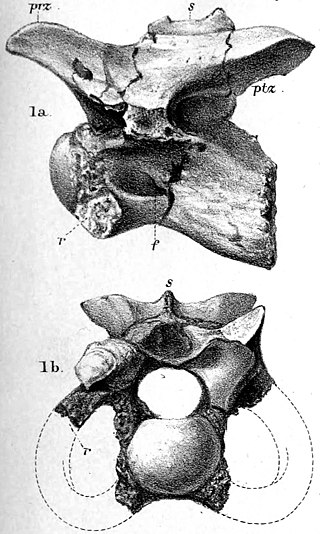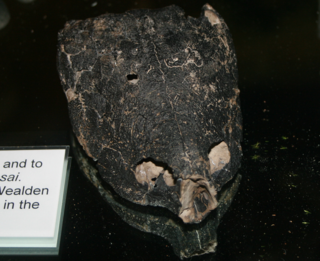
Hypsilophodon is a neornithischian dinosaur genus from the Early Cretaceous period of England. It has traditionally been considered an early member of the group Ornithopoda, but recent research has put this into question.
The Isle of Wight is one of the richest dinosaur localities in Europe, with over 20 species of dinosaur having been recognised from the early Cretaceous Period, some of which were first identified on the island, as well as the contemporary non-dinosaurian species of crocodile, turtle and pterosaur.

Weald Clay or the Weald Clay Formation is a Lower Cretaceous sedimentary rock unit underlying areas of South East England, between the North and South Downs, in an area called the Weald Basin. It is the uppermost unit of the Wealden Group of rocks within the Weald Basin, and the upper portion of the unit is equivalent in age to the exposed portion of the Wessex Formation on the Isle of Wight. It predominantly consists of thinly bedded mudstone. The un-weathered form is blue/grey, and the yellow/orange is the weathered form, it is used in brickmaking.

Neovenator is a genus of carcharodontosaurian theropod dinosaur. It is known from several skeletons found in the Early Cretaceous (Hauterivian-Barremian) Wessex Formation on the south coast of the Isle of Wight, southern England. It is one of the best known theropod dinosaurs from the Early Cretaceous of Europe.

Eotyrannus is a genus of tyrannosauroid theropod dinosaur hailing from the Early Cretaceous Wessex Formation beds, included in Wealden Group, located in the southwest coast of the Isle of Wight, United Kingdom. The remains (MIWG1997.550), consisting of assorted skull, axial skeleton and appendicular skeleton elements, from a juvenile or subadult, found in a plant debris clay bed, were described by Hutt et al. in early 2001. The etymology of the generic name refers to the animal's classification as an early tyrannosaur or "tyrant lizard", while the specific name honors the discoverer of the fossil.

Aristosuchus is a genus of small coelurosaurian dinosaur whose name was derived from the Greek ἄριστος and σουχος. It shared many characteristics with birds.
Calamospondylus is a genus of theropod dinosaur. It lived during the Early Cretaceous and its fossils were found on the Isle of Wight in southern England. The type species is C. oweni.

Calamosaurus was a genus of small theropod dinosaur from the Barremian-age Lower Cretaceous Wessex Formation of the Isle of Wight, England. It is based on two cervical vertebrae, collected by Reverend William Fox.

Thecocoelurus is a dubious genus of theropod dinosaur from the early Cretaceous period of England. The phylogenetic placement of this genus is uncertain, and it has been referred to an oviraptosaur, an ornithomimosaur, or a therizinosaur by different researchers throughout its history.

Istiodactylus is a genus of pterosaur that lived during the Early Cretaceous period, about 120 million years ago. The first fossil was discovered on the English Isle of Wight in 1887, and in 1901 became the holotype specimen of a new species, O. latidens, in the genus Ornithodesmus. This species was moved to its own genus, Istiodactylus, in 2001; this name is Greek for "sail finger". More specimens were described in 1913, and Istiodactylus was the only pterosaur known from three-dimensionally preserved fossils for much of the 20th century. In 2006, a species from China, I. sinensis, was assigned to Istiodactylus, but it has also been suggested to belong to a different genus.

The Wessex Formation is a fossil-rich English geological formation that dates from the Berriasian to Barremian stages of the Early Cretaceous. It forms part of the Wealden Group and underlies the younger Vectis Formation and overlies the Durlston Formation. The dominant lithology of this unit is mudstone with some interbedded sandstones. It is part of the strata of the Wessex Basin, exposed in both the Isle of Purbeck and the Isle of Wight. While the Purbeck sections are largely barren of vertebrate remains, the Isle of Wight sections are well known for producing the richest and most diverse fauna in Early Cretaceous Europe.

The Albanerpetontidae are an extinct family of small amphibians, native to the Northern Hemisphere during the Mesozoic and Cenozoic. The only members of the order Allocaudata, they are thought to be allied with living amphibians belonging to Lissamphibia. Despite a superficially salamander-like bodyform, their anatomy is strongly divergent from modern amphibians in numerous aspects. The fossil record of albanerpetontids spans over 160 million years from the Middle Jurassic to the beginning of the Pleistocene, about 2.13–2 million years ago.

Vectidraco, is a genus of azhdarchoid pterosaur from the Lower Cretaceous of England.

Koumpiodontosuchus is an extinct genus of neosuchian crocodyliform from the Early Cretaceous Wessex Formation of England. The only species is K. aprosdokiti, named in 2014.

Yaverlestes gassoni is an extinct mammal which dates to the early Cretaceous period, 130 million years ago. It is part of the Wessex Formation from the Isle of Wight, England. The holotype, BMNH M 54386, is a partial jaw discovered near Yaverland.

Helochelydra is an extinct genus of extinct stem turtle known from the Early Cretaceous (Barremian) of the Isle of Wight, southern England.

Ceratosuchops is a genus of spinosaurid from the Early Cretaceous (Barremian) of Britain.

Riparovenator is a genus of baryonychine spinosaurid dinosaur from the Early Cretaceous (Barremian) period of Britain. The genus contains a single species, Riparovenator milnerae.

Brighstoneus is a genus of hadrosauriform dinosaur from the Early Cretaceous Wessex Formation of the Isle of Wight, England. The genus contains a single species, Brighstoneus simmondsi, known from a partial skeleton.

Vectiraptor is a genus of dromaeosaurid dinosaur from the Barremian aged Wessex Formation of the United Kingdom. The type and only species is Vectiraptor greeni, known from associated dorsal vertebrae and a partial sacrum.



















